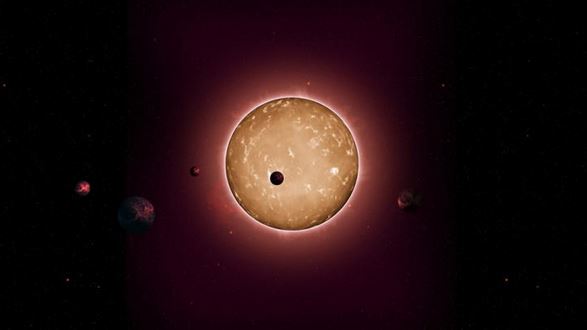Scientists who were sifting through four years’ worth of data from NASA’s Kepler spacecraft discovered an 11.2-billion-year-old star with at least five Earth-size planets orbiting it.
The star, called Kepler-444, was formed when the Universe was less than 20% of its current age. It is the oldest known system of Earth-size planets in the Milky Way (our Galaxy) – and 2.5 times older than our Sun.
The scientists carried out research by using asteroseismology – listening to the natural resonances of the host star which are caused by sound trapped within it. These oscillations lead to tiny pulses (changes) in its brightness which allow the team to measure its diameter, age and mass.

Kepler-444, a recently discovered star with at least five Earth-size planets. The system is 11.2 billion years old – more than twice the age of our Solar System. (Illustration by Tiago Campante/Peter Devine. Image: Iowa State University)
They detected the planets from the dimming that occurs when they pass across the stellar disc. With these data the astronomers can determine the size of the planets in relation to the size of the star.
Their study has been published in the Astrophysical Journal. The authors wrote:
“We thus show that Earth-size planets have formed throughout most of the Universe’s 13.8-billion-year history, leaving open the possibility for the existence of ancient life in the Galaxy.”
Study leader, Dr. Tiago Campante, from the University of Birmingham’s School of Physics and Astronomy in England, said scientists have known that Earth-size planets have formed throughout most of the Universe’s 13.8 billion year history.
Dr. Campante said:
“By the time the Earth formed, the planets in this system were already older than our planet is today. This discovery may now help to pinpoint the beginning of what we might call the ‘era of planet formation’.”
Our Sun, at 4.5 billion years of age, is a much younger star. Kepler-444 came from the first generation of stars, says co-author Steve Kawaler, an Iowa State University professor of physics and astronomy.
Prof. Kawaler said:
“This system tells us that planets were forming around stars nearly 7 billion years before our own solar system. Planetary systems around stars have been a common feature of our galaxy for a long, long time.”
Kepler-444 is 177 light years from Earth and is about 25% smaller than our sun. Its five-known planets have sizes that fall between Venus and Mercury i.e. between 95% and 38% the diameter of our planet.
The five planets are much closer to their stars than the Earth is. It takes them fewer than 10 days to complete an orbit. Being so close to their Sun, they are even hotter than Mercury and would not be able to support life as we know it.
Keppler-444 is a very bright star. In fact, you can see it with a good pair of binoculars, Prof. Kawaler said.
This latest discovery will help astronomers learn even more about the history of our Galaxy.
The authors wrote:
“From the first rocky exoplanets to the discovery of an Earth-size planet orbiting another star in its habitable zone, we are now getting first glimpses of the variety of Galactic environments conducive to the formation of these small worlds. As a result, the path toward a more complete understanding of early planet formation in the Galaxy starts unfolding before us.”
Professor Bill Chaplin, team leader in asteroseismology for the Kepler Mission, said:
“The first discoveries of exoplanets around other Sun-like stars in our Galaxy have fuelled efforts to find other worlds like Earth and other terrestrial planets outside our Solar System.”
“We are now getting first glimpses of the variety of Galactic environments conducive to the formation of these small worlds. As a result, the path towards a more complete understanding of early planet formation in the Galaxy is now unfolding before us.”
“An Ancient Extrasolar System with Five Sub-Earth-size Planets,” T. L. Campante et al. The Astrophysical Journal. 799 170. doi:10.1088/0004-637X/799/2/170. Received 22 October 2014, accepted for publication 24 December 2014. Published 27 January 2015.
Video – Kepler-444 – an ancient extrasolar system
